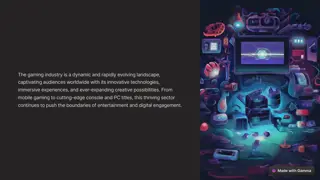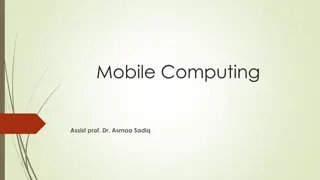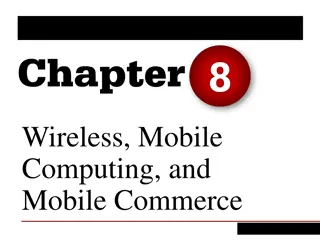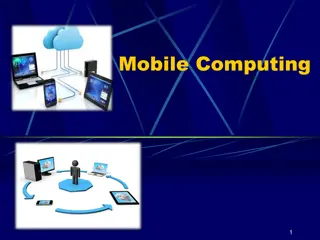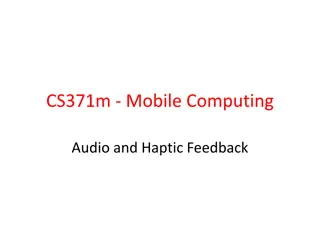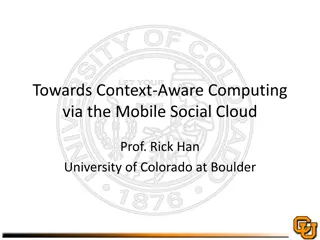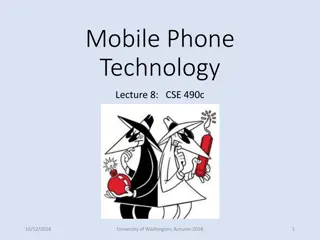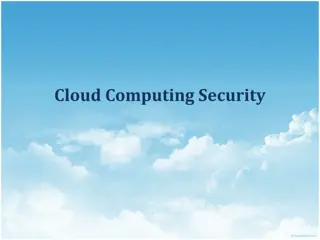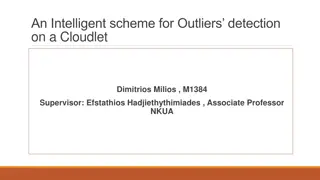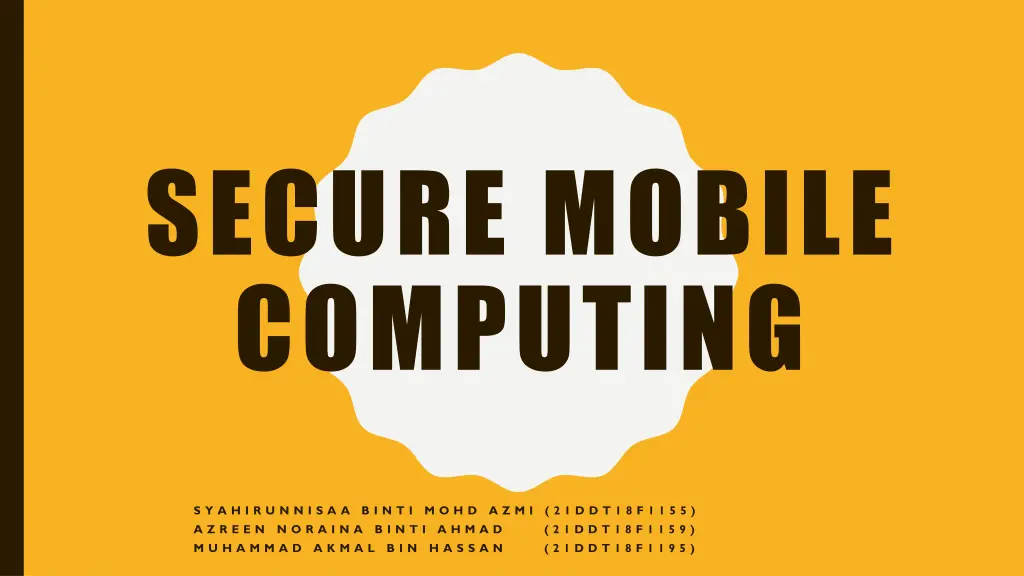
Understanding Three-Tier Architecture in Mobile Computing
Explore the concept of three-tier architecture in mobile computing, its layers - presentation, application, and data tiers, along with the role of middleware frameworks like Message-Oriented Middleware and Transaction Processing Middleware.
Download Presentation

Please find below an Image/Link to download the presentation.
The content on the website is provided AS IS for your information and personal use only. It may not be sold, licensed, or shared on other websites without obtaining consent from the author. If you encounter any issues during the download, it is possible that the publisher has removed the file from their server.
You are allowed to download the files provided on this website for personal or commercial use, subject to the condition that they are used lawfully. All files are the property of their respective owners.
The content on the website is provided AS IS for your information and personal use only. It may not be sold, licensed, or shared on other websites without obtaining consent from the author.
E N D
Presentation Transcript
SECURE MOBILE COMPUTING S Y A H I R U N N I S A A A Z R E E N M U H A M M A D A K M A L B I N H A S S A N B I N T I B I N T I M O H D A H M A D A Z M I ( 2 1 D D T 1 8 F 1 1 5 5 ) ( 2 1 D D T 1 8 F 1 1 5 9 ) ( 2 1 D D T 1 8 F 1 1 9 5 ) N O R A I N A
CLO2: Describe mobile computing infrastructure, communications, devices, platforms, and applications CLO3: Solve the issues related to the mobile security computing Question 1 [CLO2] Figure 1 below describes the mobile computing architecture or three tier architecture. Based on Figure below: i) Explain the three-tier architecture related to mobile computing (10 marks) ii) A middleware framework is defined as a later of software, which sits in the middle between the OS and under facing software. Explain the middleware categories below: a. Message-Oriented Middleware (MOM) b. Transaction Processing (TP) Middleware c. Communication Middleware (CM) d. Transcoding Middleware (TM) e. Distributed Object and Component (DOM)
Explain the three-tier architecture related to mobile computing A 3-tier architecture is a type of software architecture which is composed of three tiers or layers of logical computing. They are often used in applications as a specific type of client-server system. 3-tier architectures provide many benefits for production and development environments by modularizing the user interface, business logic, and data storage layers. gives greater flexibility to development teams by allowing them to update a specific part of an application independently of the other parts.the 3-tier architecture consist of 3 layer which are presentation layer , application tier and data tier . The presentation tier is the front end layer in the 3-tier system and consists of the user interface. This user interface is often a graphical one accessible through a web browser or web-based application and which displays content and information useful to an end user. This tier is often built on web technologies such as HTML5, JavaScript, CSS, or through other popular web development frameworks, and communicates with others layers through API calls.The application tier contains the functional business logic which drives an application s core capabilities. It s often written in Java, .NET, C#, Python, C++, etc.The data tier comprises of the database/data storage system and data access layer. Examples of such systems are MySQL, Oracle, PostgreSQL, Microsoft SQL Server, MongoDB, etc. Data is accessed by the application layer via API calls.
A middleware framework is defined as a later of software, which sits in the middle between the OS and under facing software. Explain the middleware categories below: Message-Oriented Middleware (MOM) Message Oriented Middleware (MOM) is a software/hardware infrastructure that supports the receiving and sending of messages over distributed applications. The spreading of applications over various platforms and the creation of software applications comprising many operating systems and network protocols are made less complicated. It is one of the most widely used types of middleware. Transaction Processing (TP) Middleware Transactional Middleware means the tech that reinforces the working of electronic transactions in a branched background. The best example is Transaction Processing Monitors (TPM), which have been in the market for more than 30 years
Communication Middleware (CM) Communications Middleware is computer software that enables two otherwise separate software components, processes, and/or applications to exchange information, either within one device, or between multiple devices. Transcoding Middleware (TM) Transcoding is the ability to adapt digital files so that content can be viewed on different playback devices. They are commonly used for adapting content for mobile devices or serving video. There are a number of different ways thattranscoding can take place but the overall process remains the same. Distributed Object and Component (DOM) Distributed objects are small applications that use standard interfaces and protocols to communicate with one another. Because they are built over standards, two compliant objects should be able to exchange information and carry out application functions by invoking each other methods . Two important distributed objects specifications exist, CORBA (Common Object Request Broker Architecture) and DCOM (Distributed Component Object Model). CORBA is an architecture and specification for creating, distributing, and managing distributed objects in a network.
Question 2 [CLO3] The demand of mobile and internet is increasing day by day, they are becoming the preferred means of personal and professional communication, giving a new dimension to the telecom industry. There are the evolutions of wireless network technologies from 1G to 4G commonly known as first generation (1G), second generation (2G), third generation (3G), the fourth generation (4G) and the next generation was fifth generation (5G). Explain all the five wireless network technologies based on (25 marks) i. Definition of the technologies ii. Key features and facilities iii. Advantage and disadvantages iv. Standard and Data bandwidth v. Example of devices
DEFINITION OF THE TECHNOLOGIES 1g refers to the first generation of wireless cellular technology (mobile telecommunications). These are the analog telecommunications standards that were introduced in the 1980s and continued until being replaced by 2G digital telecommunications. The main difference between the two mobile cellular systems (1G and 2G), is that the radio signals used by 1G networks are analog, while 2G networks are digital.
2g Second generation wireless telephony technology (2G) refers to telecom network technologies that were launched on the Global System for Mobile Communications (GSM) standard in 1991 by Radiolinja in Finland. The most notable upgrade of 2G over its predecessor is the digital encryption of telephone conversations, and considerably higher efficiency on the spectrum, which allows for greater penetration level for mobile phones. 2G also introduced mobile data services, beginning with SMS text messaging. 3g Third generation computers were computers that emerged due to the development of the integrated circuit (IC). They were the first steps toward computers as we know them today. Their main feature was the use of integrated circuits, which allowed them to be shrunk down to be as small as large toasters. Because of this, they gained the name microcomputers because compared to second generation computers which would occupy entire rooms and buildings, they were quite small. Well-known computers in this generation include the DEC PDP series and the IBM-360 series computers
4g Fourth generation wireless (4G) is an abbreviation for the fourth generation of cellular wireless standards and replaces the third generation of broadband mobile communications. The standards for 4G, set by the radio sector of the International Telecommunication Union (ITU-R), are denoted as International Mobile Telecommunications Advanced (IMT-Advanced). 5g Fifth-generation wireless (5G) is the latest iteration of cellular technology, engineered to greatly increase the speed and responsiveness of wireless networks. With 5G, data transmitted over wireless broadband connections could travel at rates as high as 20 Gbps by some estimates -- exceeding wireline network speeds -- as well as offer latency of 1 ms or lower for uses that require real-time feedback. 5G will also enable a sharp increase in the amount of data transmitted over wireless systems due to more available bandwidth and advanced antenna technology.
KEY FEATURES AND FACILITIES 1g Speed-2.4 kbps Allows voice calls in 1 country Use analog signal. Poor voice quality Poor battery life Large phone size Limited capacity Poor handoff reliability Poor security Offered very low level of spectrum efficiency
2g Second generation, 2G: Data speed was upto 64kbps Use digital signals Enables services such as text messages, picture messages and MMS(Multimedia message) Provides better quality and capacity Unable to handle complex data such as videos. Required strong digital signals to help mobile phones work. If there is no network coverage in any specific area, digital signals would weak.
3g Speed 2 Mbps Typically called smart phones Increased bandwidth and data transfer rates to accommodate web-based applications and audio and video files. Provides faster communication Send/receive large email messages High speed web/more security/video conferencing/3D gaming Large capacities and broadband capabilities TV streaming/mobile TV/Phone calls To download a 3 minute MP3 song only 11 sec-1.5 mins time required. Expensive fees for 3G licenses services It was challenge to build the infrastructure for 3G High bandwidth requirement Expensive 3G phones Large cell phones
4g Capable of provide 10Mbps-1Gbps speed High quality streaming video Combination of Wi-Fi and Wi-Max High security Provide any kind of service at any time as per user requirements anywhere Expanded multimedia services Low cost per-bit Battery uses is more Hard to implement Need complicated hardware Expensive equipment required to implement next generation network
5g It is highly supportable to WWWW (wireless World Wide Web) High speed, high capacity Provides large broadcasting of data in Gbps. Multi-media newspapers, watch TV programs with the clarity(HD Clarity) Faster data transmission that of the previous generation Large phone memory, dialing speed, clarity in audio/video
ADVANTAGE AND DISADVANTAGES Advantages of a 1G network : Improve voice clarity The network uses the analog signal Reduce noise in the line Secrecy and safety to data and voice calls Consume less battery power Disadvantages of a 1G network : Poor voice quality Large phone size Poor battery life No security It makes use of the mobile phone with the analog signal more difficult and this signal are suffer from interference problem Limited capacity Poor hand-off reliability Very slow speed
2g Advantages: Smaller in size compared to the first generation of computer The second generations computers were more reliable. Used less energy and were not heated as much as the first one.Wider commercial use. Better portability as compared to the first generation. Better speed and could calculate data in microseconds. Used faster peripherals. Used assembly language as well. Accuracy improved. Disadvantages Cooling system was required. Constant maintenance was require. Costly and not versatile. Commercial production was difficult. Only used for specific purposes. Punch cards were used for input
3g Advantages Faster data rates. Support multimedia applications such as video and photography. Value added services like mobile television, GPS, video call and video conference. High speed mobile internet access. Increased capacity. Disadvantages Requires 3G compatible handsets. The cost of upgrading to 3G device is expensive. Power consumption is high. 3G requires closer base stations which is expensive.
4g Advantages of 4G: Quickly download files over a wireless network Extremely high voice quality Easily access Internet, IM, social networks, streaming media, video calling Higher bandwidth 4G is 10 times faster than 3G Disadvantages of 4G: New frequencies means new components in cell towers. Higher data prices for consumers Consumer is forced to buy a new device to support the 4G It is impossible to make your current equipment compatible with the 4G network
5g Advatanges Greater speed(enough to download a movie in few seconds) Greater capacity(1,000 times capacity of 4G) Reduced Latency(stop delays) Provide high resolution and larger bandwidth It will gather networks on one platform Lower battery consumption Simultaneous connections can work together Provide uninterrupted and consistent connectivity. Allow access to parallel multiple services Remote place access grant Detect natural disasters Disadvatanges 5G network will benefit not only business person but also the commoners. There are several new things that will emerge along with 5Gnetwork making it more reliable and efficient.
STANDARD AND DATA BANDWIDTH 1G- 2.4 Kbps to 14.4 kbps 2G- 14.4 Kbps 3G 3.1 Mbps 4G 100 Mbps 5G 10 Gbps
EXAMPLE OF DEVICES 1G NORDIC MOBILE TELEPHONE 2G NOKIA 3310
3G IPHONE 3G 4G IPHONE 6
5G SAMSUNG GALAXY S10 5G

